I came across this archive of the Welsh left last
week. Its a fascinating collection that lasts from the 1950s to the
John Marrek battle within Wrexham Labour party. It deals with a
period of history that asks questions to all on the left. On Friday I
did a piece on both the Brit left and the Lexit left and was a
strange synchronicity that I came upon this information.
"It is often ignored by the traditional left. In
many cases it originates around the mistake that a Welsh socialist
Republican tradition is somehow an unconscious right wing nationalist
group. Yet the blind spot it reveals on the Lexit Left is that their
championing of the leave campaign is entirely separate from the
implications of Brexit and its consequences for those who have
experienced racist or homophobic treatment since then. We all have
blind spots and yet very few of either the Brexit Left or Brit left
see it. The issue of Wales and the issue of Brexit is a prime example
of this weakness.
This issue of Wales also has implications for
Plaid and others in the questions that it asks. Plaid has long had a
tension within it that goes back to tensions between Saunders lewis
and Gwynfor Evans, Dafydd Elis Thomas and Dafydd Wrigley and between
Leanne Woods and others. It will probably move into a new struggle in
the next ten years between Adam Price and Rhun ap Iorwerth . Looking
back over the last fifty years we see that Plaid has yet to fully
decide if it is a Socialist Party or a “Welsh Liberal Democrat”
one. The coming Plaid election contest between Adam Price and Rhun ap
Iorwerth will decide that......
Its totemic battle will be based around Green
ideas, about attitudes to Renewable s and Nuclear power and to the
issue of Europe and political moderation, it will be based about
Welsh, the market and the progress of the Corbynistas in Wales..
These documents provide similar trends and approaches. Please reflect
upon them.

I can supply a small anecdote around the
establishment of Cymru Ymlaen by John Merrick and Ron Davies. In the
Spring is 2004 I was the Leader of Wales Green Party and was invited
by both John and Ron to meet them in Vojon,s in St Helens Road in
Swansea. We had a pleasant and interesting discussion and it was
agreed that I would speak at a meeting at Wrexham Miners institute at
a meeting of the Welsh Left. At the end if the meal the owner of the
restaurant recognizing Ron Davies and John Marek asked them to sign
the visitors book . About a week later there appeared in the Brian
Walters column in the Evening Post a story about a " Secret
Curry" that had taken place between representatives of the Welsh
Left. It seemed that we had been rumbled because Lawrence Bailey
leader of Swansea Council had gone to the same restaurant a few days
later and on signing the visitors book had seen our names there.....
Ron Davies came to Davies and spoke to about fifty
members of Swansea Green Party, I attended with John Mathews a public
meeting of the left in Wrexham and spoke on the Platform with John
Merrick and Tommy Sheridan. I remember the visit well and the long
train ride from Swansea to Wrexham shared with Martin Shipton.
There were further meetings held at between myself
, Miranda Lavey and John Marek at the Welsh Assembly in Cardiff Bay
but by the coming of the European elections in June of that year no
understanding had been worked out.
Over ten years later the left in Wales still has
no clearer direction as numerous possibilities still compete and
clash with one another. Very little has changed over the years as
this fascinating archive reveals.....anyway welcome to Monday...Since
I found the archive about the Welsh Socialist Republican tradition I
seem to have alarmed Facebook's security fears. Often when I share a
post I have to fill in a code to do so... I think I have been
noticed....again..
Anyway I liked this survey from the archive......
Here is the link
https://welshsocialistrepublicanism.wordpress.com/
Document 1| Language
Document 2 | 1953 editorial
Document 3 | Welsh Republican Manifesto [1950]
Document 4 | 1965 Thayer
Document 5 |Legacy of a patriot
Document 6| 2007 Terror
Document 7 | Dennis Coslett
Document 8| John Jenkins
Document 9| John Jenkins, Royalty and the State
Document 10| Welsh TV
Document 11| The Republican Movement 1973
Document 12| Red Wales (1) 1974
Document 13| Republican Standpoint in Cymru
Document 14| IMG review of Socialism for the Welsh people
Document 15| 1980 WRSM Statement
Document 16| WSRM First Congress
Document 17| 1980 Class & National Struggles (RCLB)
Document 18| Notes on welsh nationalism and Plaid Cymru (IMG)
Document 19| The Nature of the Welsh Socialist Republican Movement (IMG)
Document 20| Plaid
Document21 | Carn 1980
Document22 | Direct Action
Document23| Police State in wales
Document24| Repression
Document25 | Writing on the Wall
Document 26| Welsh nationalists under attack
Document 27 |Robert Griffith
Document 28 |WSRM Defendants’ Statement Class Struggle February 1984
Document 29| WCCPL STATEMENT Y
Faner Goch, Issue 14 (winter 1983-84 )
Document 30| article on the trial
Document31 | Dafydd Ladd’s OPINION
Document 32 | Red Wales (2) Where We Stand 1984
Document 33 | Get Off Our Backs
Document 34 | Bere Letter 1984
Document 35 | Meibion Glyndwr Carn 65
Document 36 | Carn 100 From referendum to referendum
Document 37 | Cyfamodwyr Three
Document 38 | A Republican overview on Republican Socialist re-groupment in Wales.
Document 39 | Ranting & Raving – the lack of critical discussion of the Arts in Wales
Document 40 | Advertising Copy
ITERATURE
Baberis, McHugh & Tyldesley (2000)
Encyclopaedia of British and Irish Political Organisations. Continuum
Carn magazine – since 1973 the quarterly publication of the
Celtic League dedicated to “secure or win” the political, cultural,
social and economic freedom of the six Celtic nations – Brittany,
Cornwall, Ireland, Mann, Scotland and Wales.
Class Struggle, newspaper of the Revolutionary Communist League of Britain
https://www.marxists.org/history/erol/uk.hightide/index.htm#rclb
Clews, Roy (1980)
To Dream of Freedom: the struggle of M.A.C. and the Free Wales Army. Y Lolfa, Talybont, Wales
Cymru Goch (nd)
Get Off Our Backs! Wales A Colony
Evans, A.H. (1975)
English Historians and Welsh History: an examination (Self-published)
Evans, D. Gareth (2000)
A History of Wales 1906-2000. University of Wales Press
Griffiths, Robert (n.d. 1980?)
Turning to London: Labour’s Attitude to Wales 1898-1956 . Y Faner Goch pamphlet
Humphries, John (2008)
Freedom Fighters: Wales’s Forgotten ‘War’, 1963-1993 Cardiff: University of Wales Press
Jenkins, John (1981)
Prison Letters. Y Lolfa, Talybont, Wales
Miles, Gareth & Griffiths, Robert (1979)
Socialism For the Welsh People. Y Faner Goch pamphlet
Neil Kinnock and the Anti-Taffy League (1979) Y Faner Goch pamphlet
Osmond, John (1985)
Police Conspiracy? Y Lolfa , Talybont, Wales
Thomas, Ned (1991)
The Welsh Extremist: A Culture in Crisis
Y Lolfa; New edition Paperback [Victor Gollancz; 1st Edition (3 Jun. 1971)]
WSRM (1981) For
Socialism and National Liberation. Resolutions and Reports of the First Congress of the Welsh Socialist Republican Movement
While there continues to be a mushrooming of small protest organisations on the Welsh nationalist scene, some, like
Cymru Annibynnol (Independent Wales)
[1]
launched in 2000 as a protest against the 2001 Census’ lack of Welsh
tick box, can gain rapid attention and short-lived momentum.
Others can retain a campaigning life like
Cymuned, the organisation formed to oppose the colonialization of the Welsh-speaking areas of Wales by non-Welsh speakers,
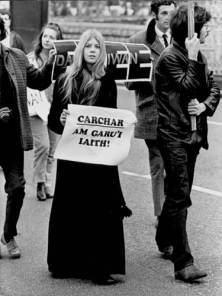
established
in 2001. It describes itself as an anti-colonisation and anti-racist
organisation and campaigns on housing issues having orchestrated
protests outside estate agents in England that sell second homes in
Wales to English people. Few would argue that there is a need for
sustainable local housing market in rural Wales. It has considered a
defensive strategy replicating something akin to the Gaeltacht in
Ireland; a defined geographical bastion of native language to p
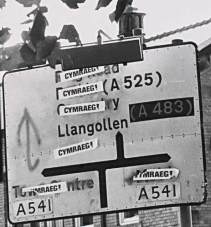
reserve
what remains of the native Welsh-speaking communities, to be known as
“Bro Gymraeg”. It echoed the idea used by the Adfer movement in the
1970s and 1980s, then their campaign caused offence by seeming to
disregard the role of Welsh-speakers outside of the designated
linguistic homeland.
The Welsh Republican Army (WRA) (
Byddin Weriniaethol Gymreig)
said to have re-formed in 2000, is a small Welsh Republican
paramilitary organisation, that traces their lineage back to the Mudiad
Amddiffyn Cymru (MAC) – Movement for the Defence of Wales and their
slogan ‘Fe godwn ni eto’: ‘
We shall rise again‘.
A spokesperson for the WRA made this statement in 2007 on its aims: “
The
WRA’s primary objective is to establish a Welsh socialist republic and
free Cymru from its shackles. We will continue to oppose the British
state’s domination and rule of our country.” It was reported in
June 2005, that The Welsh Republican Army went to the town of Cilmeri
and spray painted over the signs in the town which show the English
spelling of the town’s name, and also visited the town railway station
and sprayed Free Wales logos in the surrounding area .
Welsh freedom struggle still has some way to break the dominance of
English political allegiance and influence in Wales. Referendums on
devolution for Wales were held on 1 March 1979 _ Turnout was 58.6% _and
18 September 1997_and turnout was 50.1% in 1997. There was little
support for devolution in the 1979 referendum, with only 20.3% of voters
in favour. The 1997 referendum on the other hand produced a slim
majority in favour of a Welsh Assembly; 50.3% of voters voted ‘Yes’ to
an Assembly while 49.7% were opposed.
Yet, in the 21st century Plaid Cymru has remained the main vehicle
for proponents of Welsh independence aspirations. Plaid are clearly the
dominant party of Welsh-speaking Wales, with all the Welsh-majority
seats and their support outside the valleys, reflecting the linguistic
nature of its constituency more than anything else. It campaigned for
Welsh to become an official European Union language. On 15 July 2008 the
EU Council of Ministers approved a new status for the use of Welsh as a
“co-official” language within EU institutions. This agreement, at the
request of the UK Government means that Co-official languages can
receive certain services in the EU, such as for example interpretation
during meetings, translation of final legislation or the possibility for
citizens to correspond with EU institutions in the language.
Expression of a revival in welsh socialist republicanism continued to
be premature: April 2003 saw the publication of a new (short-lived)
radical weekly called “
Seren” / Star encompassing socialist, environmental and republican news.
In August of the same year, John Marek AM hosted the conference, “Red
green and radical – building a left alternative in Wales”. It attracted
speculation of the formation of a new political party corresponding to
the SSP in Scotland, indeed Tommy Sheridan, the most prominent Scottish
Socialist Party member of the Scottish Parliament, was a speaker at the
conference. Marek was thought a strange candidate to unify the radical
left, as a commentary in
Carn observed, he:
“
would still be a New Labour AC if he had not been deselected by
his local Labour party, is a unionist with a dubious attitude towards
the language.” [2]
In late 2003, Cymru Goch subsumed itself into the new Forward Wales
party formed around the ex-Labour member of the Welsh Assembly John
Marek. That party was disbanded in 2010.
Mike Davies provided a republican overview on “Republican Socialist
re-groupment in Wales” in the first few years of the 21st Century:
- Document 38 | A Republican overview on Republican Socialist re-groupment in Wales.[3]
Socialist republicans have been a tiny force in Welsh politics
for the past 20 years. During that time Cymru Goch, although a dynamic
party that published the only monthly Welsh political paper, reached out
to other socialists and republicans through a series of unity ventures
that culminated in the unsuccessful Welsh Socialist Alliance.
This was cynically hijacked by the Socialist Workers Party, who
used it as an electoral vehicle without appreciating the need for a
deeper alliance to unite the left in Wales. The problem with trying to
create left unity in Wales, unlike Scotland, is that the British left
groups here (small though they are) have never accepted the need for
separate organisation.
This led to Cymru Goch reluctantly withdrawing from the WSA in
2002. It then organised a highly successful three-day event opposing the
Queen’s jubilee with speakers from the IRSP, SSP attending Clwb y Bont
in Pontypridd. It turned out to be something of a swansong for the
organisation.
That summer, the party agreed, in an attempt to broaden its
appeal, to launch a monthly tabloid paper called Seren (Socialist,
Environmental, Republican News). The aim was to link up the various
left, trade union and community campaigns in a practical if loose
alliance – an attempt to build a grassroots unity based on cooperation
rather than forced mergers between sectarian groupings.
As luck had it, the launch coincided with the growing anti-war
protests and for a time Seren went weekly to reflect the activities
throughout Wales. It succeeded in building up a network of distributors
way beyond CG’s membership.
Then in March 2003, Wrexham’s Assembly Member John Marek was
deselected by Labour. After talks with local socialists, he decided to
stand as an independent in the May 2003 Assembly elections. Marek had
become an increasingly vocal critic of New Labour from a left reformist
viewpoint – he had given much practical support to the anti-war movement
and recent firefighters’ strike.
His success in the election—stunningly overturning a solid Labour
majority—led to meetings with the SSP and Marek himself called for a
Welsh Socialist Party. Unfortunately, he was also under the influence of
a Labourite clique and soon pulled back from an SSP-style party,
preferring instead to opt for Forward Wales. This sought to unite the
left without clarity on the national question and pulled its punches on
socialism – not a good start but the left within it (including ex
CG-comrades) felt it was a step in the right direction and couldn’t be
ignored.
Fudging key issues kept many socialist republicans from joining
the new party, leaving the Labourites in the ascendancy. The party
continued to move on, gaining a councillor in local elections and
winning over Ron Davies, the ex-Welsh Secretary. This, although a
publicity coup, only succeeded in strengthening the reformist grip on
the party.
The ongoing tensions between the left and the ex-Labourites,
coupled with Marek’s effective sole funding of the party through his
salary and allowances, ended with the left (including the sole
councillor, national secretary and press officer) quitting the party.
Seren continued to publish, maintaining links between leftists in
all parties, although it’s fair to say that most are now not in any
organisation. Financial pressures led to Seren becoming a web-based
publication—http://seren.blogspirit.com—and socialist republicans in Wales continue to be in a state of re-groupment.
Some have opted to join Plaid Cymru, which has a strong socialist
republican grouping based around Leanne Wood AM and Jill Evans, the
party’s Euro-MP. Leanne in particular has become the most prominent
republican in Wales with her principled objections to the Queen opening
the Assembly building on March 1.
The electoral system, not the be all and end off for socialists
of course, militates against an SSP-style party in Wales breaking
through. In Scotland, the PR system has allowed both the SSP and Greens
to win seats while in Wales there is little hope of that happening
because the list system is far more restrictive. The party has moved
significantly to the left in recent years, calling itself “the socialist
party of Wales” in the last General Election and moving away from its
cultural nationalist heritage. In truth, it always had a left-wing
element but that was dominated by a cultural nationalism in the post-war
years.
It has been a consistent voice for environmental campaigners and
aligned itself with the anti-war movement. Adam Price MP, another left
voice in the party, is seen as a future leader and has established close
links with dissident left union leaders such as Bob Crow of the RMT
railworkers’ union.
Independence is not an issue fudged, socialism is central to its
liberation agenda and there has always been an environmental, grassroots
element to Plaid’s political message. Plaid, in short, is a world away
from the SNP’s right-wing nationalist vision and – for this writer at
least – seems like the natural home for Welsh socialist republicans. At a
time when there is no Welsh republican organisation and the British
left has all but vanished in Wales, the presence of a credible left-wing
party in Plaid Cymru is heartening to say the least. Socialists within
Plaid will be working to ensure that it can take control of the Assembly
in the May 2007 elections against a Labour Party beset by sleaze and
scandal.
**
Post-devolution we’re a post-colonial country still waiting to be
decolonised. It is these contradictions that describe our present
predicament: we are a hybrid state living in the cracks between a
dependent past and an independent future.
Thus in November 2009, Adam Price, then Plaid’s MP for Dinefwr and East Carmarthenshire
[4]
had tried to describe the Welsh dilemma, or as Gareth Miles argued in
‘Ranting and Ravings’ a submission to the Welsh Arts Council that same
year, “many of our critics, like the majority of their compatriots, are
not sure exactly what Wales is.”
Gareth_Miles_-_The_lack_of_critical_discussion_of_the_Arts_in_Wales
The self-declared Socialist republican, Leanne Wood was elected
leader of Plaid Cymru on 15 March 2012. The first female leader of Plaid
Cymru was the first party leader to be a Welsh learner rather than
already fluent in the Welsh language. A Member of the National Assembly
for Wales since 2003, her Plaid Cymru profile includes her commitment to
working “for Wales to become a self-governing decentralist socialist
republic”.
On the fringe doubts were expressed:
Leanne Wood taking the leadership of Plaid Cymru will spread and
perpetuate the illusion that Plaid Cymru is or can become a vehicle for a
progressive, socialist and republican movement, that Plaid Cymru can
challenge the Westminster imposed austerities, take Wales out of the
neo-imperialist wars in the middle east and elsewhere, and get rid of
those imposters posing as the Prince and Princess of Wales.[5]
Despite the historical discontinuities, what reasserted itself is the
idea that a socialist and republican Wales is a desired goal necessary
for a progressive and equal society. Internet activism opportunities
sees the spirit and message of welsh socialist republicanism still
broadcasted by bloggers like Gethin ‘Iestyn’ Gruffydd and Nickglais,
editor of
Democracy and Class Struggle blogsite and also a member of
Great Unrest Group 2012 for a Welsh Socialist Republican Party. There are individual social media venues, such as
Y Repwblic ~ Conversations with Wales’ Republicans, that act to preserve and advance various strands of radical thought
[6] and elsewhere on the internet,
Radical Wales[7]
exists as an independent platform for considered radical political
analysis, commentary and discussion. It strives to contribute by
providing a space for the extra-parliamentary left of anarchists,
communists, greens, left-republicans and socialists outside of the major
political parties to explore issues important to them. It says:
“
Inspired by the long line of rebels and revolutionaries who have
stood outside and against the political process of the ruling class in
Wales, we publish original articles that continue that tradition.”
The latest manifestation of that ideal sprouting again at the margins
of the political life but arguing the points made by others throughout
the modern history of Wales, was in the appearance in March 2013 of a
magazine advertised as
Liberation Magazine – Voice of Welsh Socialist Republicanism
- Document 40 | Advertising Copy
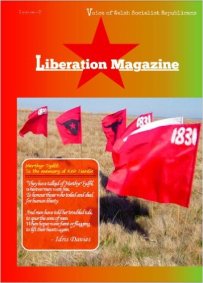 The
reason for launching Liberation Magazine is that we take the view you
cannot win a game where the rules are made by your opponent.
In the case of Wales, the British State determines the rules and
Welsh people are supposed to play the Welsh Assembly game according to
its rules.
It is arrogant imperial intellectual and practical
colonialism where very important decisions on Welsh Life are taken in
London and not Wales.
The Welsh are closetly seen as unfit to govern their own country.
Liberation Magazine unashamedly stands for a Welsh Socialist
Republic an idea that has been maturing in Wales for over a century.
The Labour Party and Plaid Cymru in Wales have never really embraced the idea of Welsh Socialist Republic.
Sometimes Plaid Cymru flirts with the idea but quickly backtracks under pressure.
Monarchism has not only infected the Labour Party but also sections of Plaid Cymru.
We launched Liberation Magazine because we want a journal where
the Welsh, the Socialist and the Republican cases can be argued and
discussed.
A new strategy and new tactics needs to be developed for the
social and national liberation of Wales in the 21st Century if Wales is
to arrest its current trajectory of economic and social decline.
Liberation Magazine is about ideas, the precursor of events and the inspirer of people.
“Great minds discuss ideas; average minds discuss events; small minds discuss people”.
The
reason for launching Liberation Magazine is that we take the view you
cannot win a game where the rules are made by your opponent.
In the case of Wales, the British State determines the rules and
Welsh people are supposed to play the Welsh Assembly game according to
its rules.
It is arrogant imperial intellectual and practical
colonialism where very important decisions on Welsh Life are taken in
London and not Wales.
The Welsh are closetly seen as unfit to govern their own country.
Liberation Magazine unashamedly stands for a Welsh Socialist
Republic an idea that has been maturing in Wales for over a century.
The Labour Party and Plaid Cymru in Wales have never really embraced the idea of Welsh Socialist Republic.
Sometimes Plaid Cymru flirts with the idea but quickly backtracks under pressure.
Monarchism has not only infected the Labour Party but also sections of Plaid Cymru.
We launched Liberation Magazine because we want a journal where
the Welsh, the Socialist and the Republican cases can be argued and
discussed.
A new strategy and new tactics needs to be developed for the
social and national liberation of Wales in the 21st Century if Wales is
to arrest its current trajectory of economic and social decline.
Liberation Magazine is about ideas, the precursor of events and the inspirer of people.
“Great minds discuss ideas; average minds discuss events; small minds discuss people”.
– Eleanor Roosevelt.
Our ambition is to create new ideas and start a winning game for Wales."

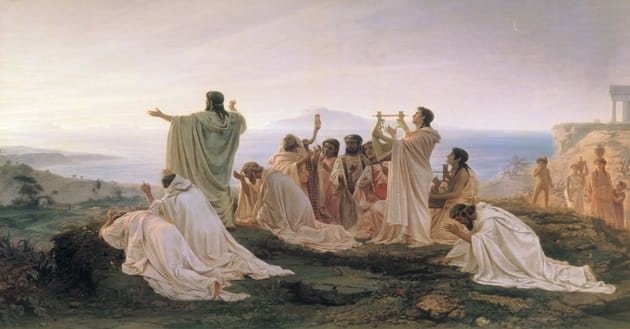







 established
in 2001. It describes itself as an anti-colonisation and anti-racist
organisation and campaigns on housing issues having orchestrated
protests outside estate agents in England that sell second homes in
Wales to English people. Few would argue that there is a need for
sustainable local housing market in rural Wales. It has considered a
defensive strategy replicating something akin to the Gaeltacht in
Ireland; a defined geographical bastion of native language to p
established
in 2001. It describes itself as an anti-colonisation and anti-racist
organisation and campaigns on housing issues having orchestrated
protests outside estate agents in England that sell second homes in
Wales to English people. Few would argue that there is a need for
sustainable local housing market in rural Wales. It has considered a
defensive strategy replicating something akin to the Gaeltacht in
Ireland; a defined geographical bastion of native language to p reserve
what remains of the native Welsh-speaking communities, to be known as
“Bro Gymraeg”. It echoed the idea used by the Adfer movement in the
1970s and 1980s, then their campaign caused offence by seeming to
disregard the role of Welsh-speakers outside of the designated
linguistic homeland.
reserve
what remains of the native Welsh-speaking communities, to be known as
“Bro Gymraeg”. It echoed the idea used by the Adfer movement in the
1970s and 1980s, then their campaign caused offence by seeming to
disregard the role of Welsh-speakers outside of the designated
linguistic homeland.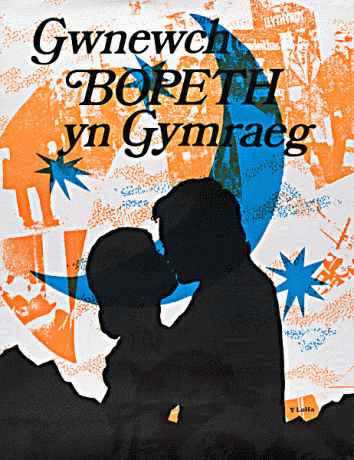
 The
reason for launching Liberation Magazine is that we take the view you
cannot win a game where the rules are made by your opponent.
The
reason for launching Liberation Magazine is that we take the view you
cannot win a game where the rules are made by your opponent.